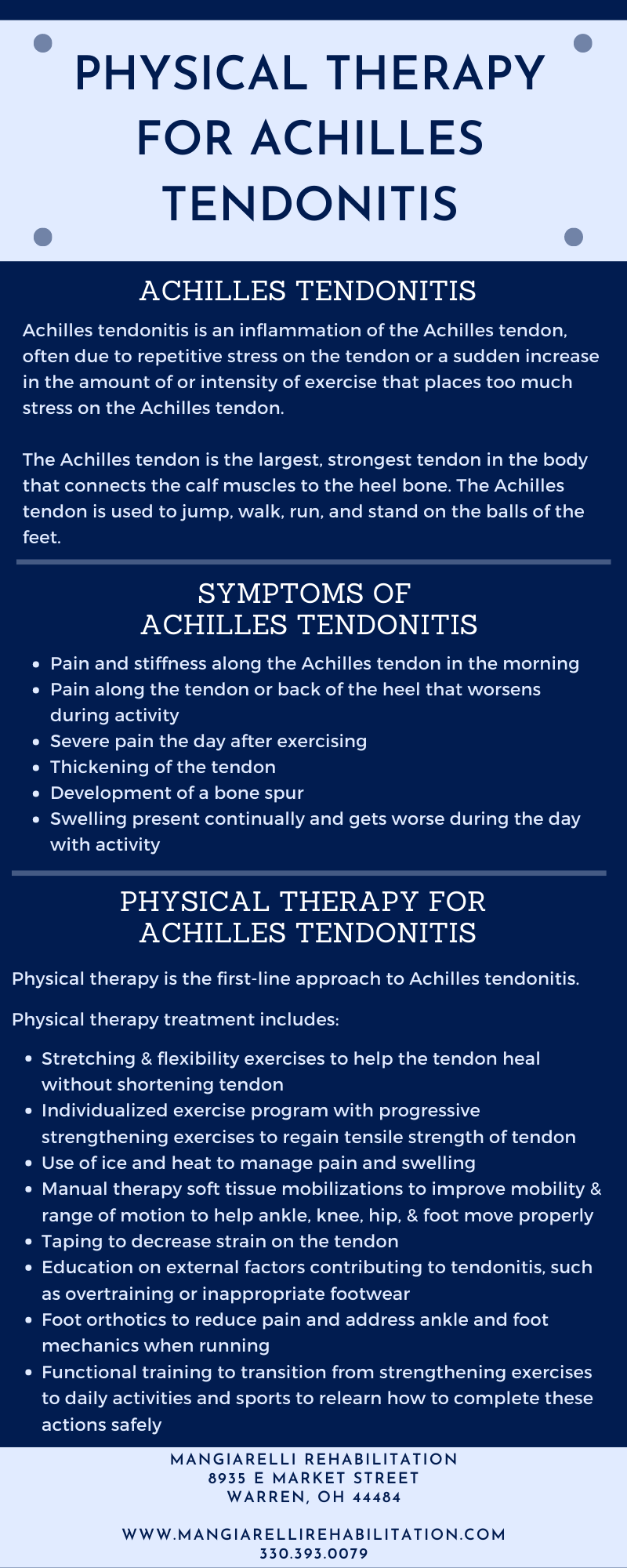Physical Therapy for Achilles Tendonitis Infographic
Achilles tendonitis is an inflammation of the Achilles tendon, which is the largest, strongest tendon in the body connecting the calf muscles to the heel bone. The Achilles tendon plays a key role in jumping, walking, running, and standing on the balls of the feet. Achilles tendonitis often develops due to repetitive stress on the tendon or a sudden increase in the amount or intensity of exercise that places too much stress on the Achilles tendon. Achilles tendonitis can occur within the tendon itself or at the point where the tendon attaches to the heel bone.
Achilles tendonitis commonly affects athletes, particularly runners and those engaged in sports requiring running, jumping, and explosive movements, such as track and field, tennis, basketball, and soccer. Running can place up to 12.5 times a person’s body weight on the Achilles tendon. Achilles tendonitis also affects a fifth of the population over age 50. With age, the tendon sustains long-term wear and tear and receives a reduced blood supply, which places the tendon at greater risk of injury.
Common symptoms of Achilles tendonitis include pain and stiffness along the Achilles tendon in the morning, severe pain the day after exercising, pain along the tendon or back of the heel that worsens during activity, thickening of the tendon, development of a bone spur, and swelling present continually that gets worse during the day with activity.
Individuals can be more prone to Achilles tendonitis if they have calf muscle tightness and weakness, abnormal foot structure and mechanics, wear improper shoes for activities, or if they have made a sudden change and increase in the intensity of exercise.
Physical therapy is the first-line approach to the treatment of Achilles tendonitis. Physical therapy helps to decrease pain and swelling of the Achilles tendon, strengthen the affected area, improve flexibility and mobility, and help individuals return to their daily activities and sports safely and gradually.
Physical therapy treatment for Achilles tendonitis includes pain management using ice and heat; taping to decrease strain on the tendon; stretching and flexibility exercises to help the tendon heal without shortening the tendon; progressive strengthening exercises to regain tensile strength of tendon, using eccentric exercises to improve function and a lower-extremity resistance program to correct muscle weakness-associated movement dysfunction that contributed to irritation of tendon; manual therapy to improve mobility and range of motion; education on overtraining and inappropriate footwear that contributed to tendonitis; foot orthotics; and functional training to return to sport and activity.
Achilles tendonitis can negatively affect your ability to walk, run, jump, and play your sport at the highest level. If you are experiencing pain in the Achilles tendon, consult with a physical therapist to regain function, manage pain, and return to activity safely.
